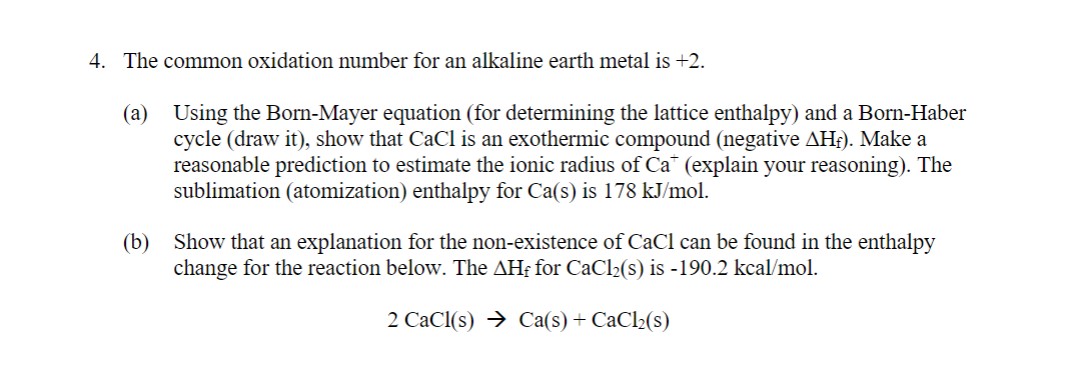4. The common oxidation number for an alkaline earth metal is +2. (a) Using the Born-Mayer equation (for determining the lattice enthalpy) and a Born-Haber cycle (draw it), show that CaCl is an exothermic compound (negative AH;). Make a reasonable prediction to estimate the ionic radius of Ca* (explain your reasoning). The sublimation (atomization) enthalpy for Ca(s) is 178 kJ/mol. (b) Show that an explanation for the non-existence of CaCl can be found in the enthalpy change for the reaction below. The AHț for CaCl2(s) is -190.2 kcal/mol. 2 CaCl(s) → Ca(s) + CaCl2(s)
4. The common oxidation number for an alkaline earth metal is +2. (a) Using the Born-Mayer equation (for determining the lattice enthalpy) and a Born-Haber cycle (draw it), show that CaCl is an exothermic compound (negative AH;). Make a reasonable prediction to estimate the ionic radius of Ca* (explain your reasoning). The sublimation (atomization) enthalpy for Ca(s) is 178 kJ/mol. (b) Show that an explanation for the non-existence of CaCl can be found in the enthalpy change for the reaction below. The AHț for CaCl2(s) is -190.2 kcal/mol. 2 CaCl(s) → Ca(s) + CaCl2(s)
Chemistry & Chemical Reactivity
10th Edition
ISBN:9781337399074
Author:John C. Kotz, Paul M. Treichel, John Townsend, David Treichel
Publisher:John C. Kotz, Paul M. Treichel, John Townsend, David Treichel
Chapter7: The Structure Of Atoms And Periodic Trends
Section7.6: Periodic Trends And Chemical Properties
Problem 2.4ACP
Related questions
Question

Transcribed Image Text:4. The common oxidation number for an alkaline earth metal is +2.
(a) Using the Born-Mayer equation (for determining the lattice enthalpy) and a Born-Haber
cycle (draw it), show that CaCl is an exothermic compound (negative AHf). Make a
reasonable prediction to estimate the ionic radius of Ca (explain your reasoning). The
sublimation (atomization) enthalpy for Ca(s) is 178 kJ/mol.
(b) Show that an explanation for the non-existence of CaCl can be found in the enthalpy
change for the reaction below. The AHf for CaCl2(s) is -190.2 kcal/mol.
2 CaCl(s) → Ca(s) + CaCl2(s)
Expert Solution
This question has been solved!
Explore an expertly crafted, step-by-step solution for a thorough understanding of key concepts.
This is a popular solution!
Trending now
This is a popular solution!
Step by step
Solved in 3 steps with 2 images

Recommended textbooks for you

Chemistry & Chemical Reactivity
Chemistry
ISBN:
9781337399074
Author:
John C. Kotz, Paul M. Treichel, John Townsend, David Treichel
Publisher:
Cengage Learning

Chemistry: The Molecular Science
Chemistry
ISBN:
9781285199047
Author:
John W. Moore, Conrad L. Stanitski
Publisher:
Cengage Learning


Chemistry & Chemical Reactivity
Chemistry
ISBN:
9781337399074
Author:
John C. Kotz, Paul M. Treichel, John Townsend, David Treichel
Publisher:
Cengage Learning

Chemistry: The Molecular Science
Chemistry
ISBN:
9781285199047
Author:
John W. Moore, Conrad L. Stanitski
Publisher:
Cengage Learning


Chemistry: Principles and Reactions
Chemistry
ISBN:
9781305079373
Author:
William L. Masterton, Cecile N. Hurley
Publisher:
Cengage Learning

Chemistry & Chemical Reactivity
Chemistry
ISBN:
9781133949640
Author:
John C. Kotz, Paul M. Treichel, John Townsend, David Treichel
Publisher:
Cengage Learning

Chemistry: Principles and Practice
Chemistry
ISBN:
9780534420123
Author:
Daniel L. Reger, Scott R. Goode, David W. Ball, Edward Mercer
Publisher:
Cengage Learning